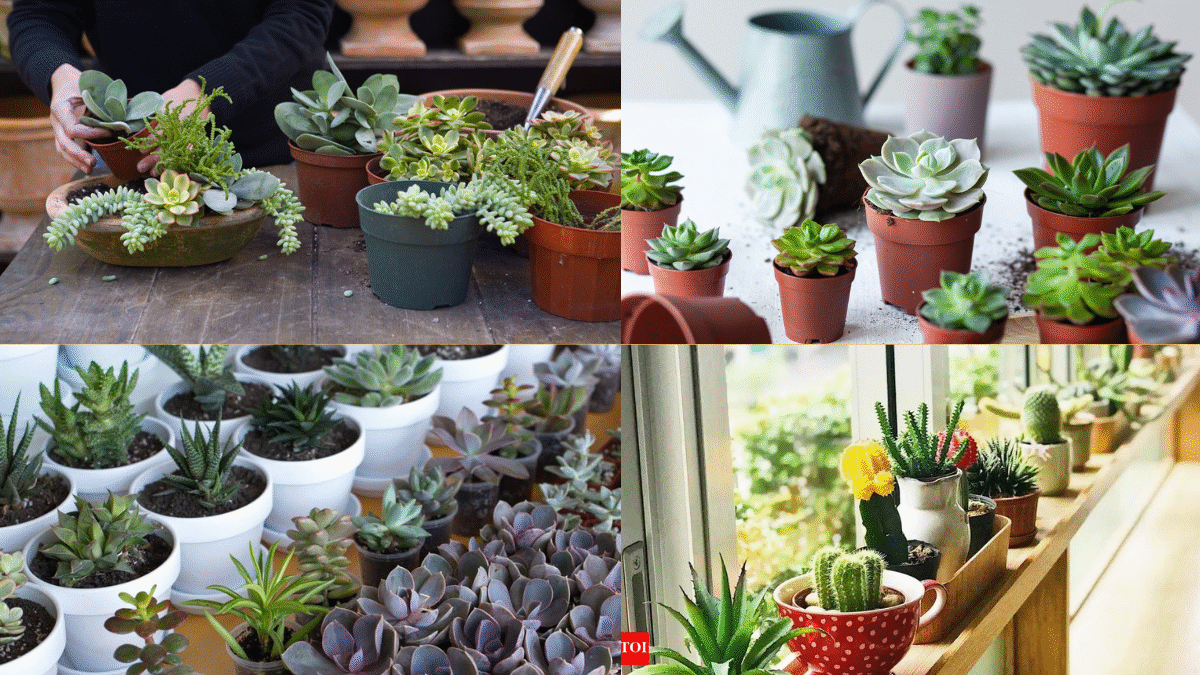If you’ve been looking for a way to add some effortless charm to your indoor or outdoor spaces, succulents are the answer. These hardy, water-storing plants have exploded in popularity thanks to their sculptural shapes, striking colors, and easy-care nature. Whether you’re a busy plant lover, a beginner gardener, or simply drawn to their modern aesthetic, planting succulents is a rewarding, low-maintenance way to beautify your space.
In this guide, we’ll walk you through how to plant succulents for long-lasting, low-maintenance beauty, from choosing the right varieties to soil prep, planting techniques, and simple care tips.
Why Choose Succulents?
Succulents aren’t just trendy — they’re practical, too. Here’s why gardeners and decorators love them:
- Low Water Needs: Succulents store water in their leaves, stems, or roots, making them drought-tolerant.
- Versatile Design Options: From hanging baskets and terrariums to rock gardens and living walls, succulents thrive almost anywhere.
- Minimal Maintenance: Perfect for people with busy lifestyles or those new to gardening.
- Variety of Shapes and Colors: With thousands of types, you can create stunning displays featuring an array of hues, textures, and forms.
- Great Indoors and Outdoors: Depending on your climate, succulents can thrive both inside and outside your home.
Best Succulent Varieties for Beginners
If you’re new to growing succulents, start with easy-care species. Here are some beginner-friendly favorites:
- Echeveria: Rosette-shaped with pastel shades.
- Aloe Vera: Medicinal and attractive with spiky green leaves.
- Jade Plant (Crassula ovata): Hardy and forgiving with thick, glossy leaves.
- Sedum (Stonecrop): Low-growing with diverse textures.
- Hens and Chicks (Sempervivum): Compact, clumping rosettes.
- Zebra Plant (Haworthia): Small, striped leaves perfect for containers.
When to Plant Succulents
Succulents can be planted indoors year-round. For outdoor planting, wait until temperatures consistently stay above 50°F (10°C) to avoid cold damage.
Ideal Planting Seasons:
- Spring and early summer: Best for outdoor planting and repotting.
- Anytime indoors: As long as there’s good light.
Where to Plant Succulents
Succulents love bright, warm spots with excellent drainage.
Ideal Conditions:
- Indoors: Near a sunny window, preferably south or east-facing.
- Outdoors: In a sunny location that gets at least 6 hours of direct sunlight daily.
- Containers: Choose pots with drainage holes to prevent root rot.
- Soil: Well-draining cactus or succulent mix.
Preparing the Right Soil for Succulents
The most critical aspect of growing healthy succulents is using the right soil.
Avoid Regular Potting Soil!
Succulents hate “wet feet” — soggy roots lead to rot. Opt for a fast-draining soil mix designed for cacti and succulents.
DIY Succulent Soil Mix:
- 2 parts coarse sand or perlite
- 2 parts potting soil
- 1 part pumice or small gravel
This blend ensures quick drainage while retaining just enough moisture.
How to Plant Succulents: Step-by-Step
Here’s how to plant your succulents like a pro — whether in a pot, a garden bed, or a decorative container.
Supplies You’ll Need:
- Succulent plants
- Well-draining soil mix
- Container with drainage holes
- Small trowel or spoon
- Decorative pebbles or gravel (optional)
Steps for Planting Succulents:
- Choose Your Container: Pick a pot with a drainage hole. If using a decorative container without drainage, create a layer of pebbles at the bottom and water very sparingly.
- Add Soil: Fill the pot with well-draining succulent soil, leaving space for the plant.
- Remove the Succulent from Its Pot: Gently loosen the roots, especially if they’re tightly wound.
- Plant the Succulent: Place the plant in the soil so the base of the leaves sits just above the soil line. Avoid burying leaves, as this can cause rot.
- Backfill and Firm the Soil: Gently add more soil around the plant and press down lightly to eliminate air pockets.
- Decorate (Optional): Top with small decorative rocks or gravel to give a finished look and help prevent soil splashing when watering.
- Water Lightly: Wait about a day after planting before watering to allow any root damage to heal, then give it a light drink.
Watering Succulents Properly
The golden rule: when in doubt, don’t water.
How Often to Water:
- Indoors: Every 2–3 weeks, depending on the season and humidity.
- Outdoors: About once a week during the growing season; less often in winter.
Signs it’s Time to Water:
- The soil is completely dry to the touch.
- Leaves begin to wrinkle slightly (not shrivel).
Watering Technique:
- Water deeply until it runs out of the drainage holes.
- Empty excess water from saucers.
- Avoid getting water on the leaves, which can cause rot.
Light and Temperature Requirements
Light:
- Indoors: 6–8 hours of bright, indirect light daily.
- Outdoors: Full sun is best, though some types (like Haworthia) prefer partial shade.
Temperature:
- Thrive between 60–80°F (15–27°C).
- Bring outdoor succulents indoors if temperatures drop below 40°F (4°C).
Succulent Care and Maintenance
Fertilizing:
- Apply a balanced, diluted succulent fertilizer once a month during the growing season (spring and summer).
- No need to fertilize in fall and winter.
Repotting:
- Repot when the plant outgrows its container, usually every 2–3 years.
- Use fresh soil and a slightly larger pot.
Pruning:
- Remove dead leaves and spent blooms.
- Trim leggy stems to encourage fuller growth.
Common Pests and Problems
While generally pest-resistant, succulents can face a few issues:
Pests:
- Mealybugs (white cottony spots)
- Spider mites (webbing and tiny dots on leaves)
- Fungus gnats (in overly wet soil)
Problems:
- Root Rot: Caused by overwatering.
- Sunburn: White or brown scorched patches on leaves from too much direct sun.
Solutions:
- Isolate affected plants.
- Use insecticidal soap or neem oil.
- Adjust watering and light as needed.
Fun Succulent Display Ideas
One of the joys of succulents is their versatility. Try these creative display ideas:
- Wall-mounted planters
- Hanging baskets
- Teacup or mug planters
- Terrariums with decorative sand layers
- Rock gardens with mixed succulents
Final Thoughts
Succulents are the ultimate low-maintenance plants, combining hardy resilience with visual appeal. Whether clustered in a sunny windowsill, cascading from a hanging planter, or filling out a drought-tolerant landscape, they bring effortless beauty to any setting.
By choosing the right varieties, using well-draining soil, mastering their minimal watering needs, and giving them ample light, you’ll enjoy thriving, sculptural plants that require little fuss and deliver year-round charm.
So go ahead — pick your favorite succulents, gather a few charming containers, and plant your way to a stunning, low-maintenance botanical display.





Leave A Comment